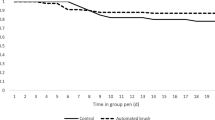Abstract
Inadequate corral facilities and improper handling are major causes of stress in beef cattle. The purpose of this study was to evaluate the effects of minor changes in the corral and adoption of good handling practices on the behavior, cortisol release, and time spent taking blood samples in Nellore cows. Minor corral changes included obstructing the cow’s vision when the handler walked deep into the animal’s flight zone and the elimination of bright objects, color contrasts, puddles, shadows, and darkness in the corral. Handling was improved by eliminating dogs, electric goads (prods), and yelling, as well as adopting a calm behavior. A total of 141 Nellore cows from two typical extensive livestock farms were studied. The cows were evaluated individually before and after the corral changes. Blood samples were collected in the restraint device for cortisol measurement. The minor corral changes and the adoption of good handling practices result in better results for all variables studied. The results showed differences in the interactions between treatment and ranch for chute score (P = 0.0091) and exit score (P < 0.0001). The cortisol release was lower (P < 0.001) and better for the improved methods, resulting in calmer cows compared to cortisol released before the minor changes (41.03 ± 2.9 vs 60.40 ± 3.8 ng/mL). Minor changes made in the corrals and the adoption of good handling practices were effective in improving cow behavior in the chute and in reducing exit velocity, cortisol released, and the time spent taking blood samples.

Similar content being viewed by others

References
Burdick, N.C., Carroll, J.A., Hulbert, L.E., 2010. Relationships between temperament and transportation with rectal temperature and serum concentrations of cortisol and epinephrine in bulls, Livestock Science, 129, 166–172
Cooke, R.F., 2014. Temperament and acclimation to human handling influence growth, health, and reproduction reponses in Bos turus and Bos indicus cattle, Journal of Animal Science, 92, 5325–5333
Grandin, T., 2015. Improving Animal Welfare—A Pratical Approach, 2nd edition (Cambridge University Press, Cambridge)
Grandin, T., Deesing, M., 2008. Humane Livestock Handlin, 1st edition (Storey Publishing, North Adams)
Lay, D.C. Jr, Friend, T.H., Randelt, R.D., Bowers, C.L., Grissom, K.K., Jenkins, O.K., 1992. Behavioral and Physiological Effects of Freeze or Hot-Iron Branding on Crossbred Cattle, Journal of Animal Science, 70, 330–336
Lyles, J.L., Calvo-Lorenzo, M.S., 2014. Practical developments in managing animal welfare in beef cattle: What does the future hold?, Journal of Animal Science, 92, 5334–5344
Macedo, G.G., Zúcarri, C.E.S.N., Gomes, U.G.P.A., Negrao, J.A., Silva, E.V.C., 2011. Human-animal interactions, stress, and embryo production in Bos indicus embryo donors under tropical conditions, Tropical Animal Health and Production, 43, 1175–1182
MacKay, J.R.D., Turner, S.P., Hyslop, J., Deag, J.M., Haskell, M.J., 2013. Short-term temperament tests in beef cattle relate to long-term measures of behavior recorded in the home pen, Journal of Animal Science, 91, 4917–4924
Mormede, P., Andanson, S., Auperin, B., Beerda, B., Guemene, D., Malmkvist, J., Manteca, X., Manteuffel, G., Prunet, P., Van Reenen, C.G., 2007. Exploration of the hypothalamic-pituitary-adrenal function as a tool to evaluate animal welfare, Physiology & Behavior, 92, 317–339
Muller, R., Schwartzkopf-Genswein, K.S., Shah, M.A., Keyserlingk, G., 2008. Effect of neck injection and handler visibility on behavioral reactivity of beef steers, Journal of Animal Science, 86, 1215–1222
Paranhos da Costa, M.J.R., Huertas, S.M., Gallo, C., Dalla Costa, O.A., 2012. Strategies to promote farm animal welfare in Latin America and their effects on carcass and meat quality traits, Meat Science, 92, 221–226
Petherick, J.C., Doogan, V.J., Holroyd, R.G., 2009. Quality of handling and holding yard environment, and beef cattle temperament: 1. Relationships with flight speed and fear of humans. Applied Animal Behavior Science, 120, 18–27
Rueda, P.M., Sant’Anna, A.C., Valente, T.S., Paranhos da Costa, M.J.R., 2015. Impact of the temperament of Nellore cows on the quality of handling and pregnancy rates in fixed-time artificial insemination, Livestock Science, 177, 189–195
Schwartzkopf-Genswein, K.S., Shah, M.A., Church, J.S., Haley, D.B., Janzen, K., Truong, G., Atkins, G.R., Crowe, T.G., 2012. A comparison of commonly used and novel electronic techniques for evaluating cattle temperament, Canadian Journal Animal Science, 92, 21–31
Tucker, C.B., Coetzee, J.F., Stookey, J.M., Thomson, D.U., Grandin, T., Schwartzkopf-Genswein, K.S., 2015. Beef cattle welfare in the USA: identification of priorities for future research, Animal Health Research Reviews, 16, 107–124
Turner, S.P., Navajas, E.A., Hyslop, J.J., Ross, D.W., Richardson, R.I., Prieto, N., Bell, M., Jack, M.C., Roehe, R., 2011. Associations between response to handling and growth and meat quality in frequently handled Bos taurus beef cattle, Journal of Animal Science, 89, 4239–4248
Vetters, M.D.D., Engle, T.E., Ahola, J.K., Grandin, T., 2013. Comparison of flight speed and exit score as measurements of temperament in beef cattle, Journal of Animal Science, 91, 374–381
Woiwode, R., Grandin, T., Kirch, B., Paterson, J., 2016. Effects of initial handling practices on behavior and average daily gain of fed steers, International Journal of Livestock Production, 7, 12–18
Acknowledgements
The data collection was made in Carpa Serrana and Fazenda Três Marias, which are gratefully acknowledged.
Funding
This study had financial support from Fapesp grant no: 2013/25355-6.
Author information
Authors and Affiliations
Corresponding author
Ethics declarations
All procedures were conducted in accordance with Ethics Committee of the Animal Science Institute of Sao Paulo, Brazil.
Conflict of interest
The authors declare that they have no conflicts of interest.
Rights and permissions
About this article
Cite this article
Lima, M.L.P., Negrão, J.A., de Paz, C.C.P. et al. Minor corral changes and adoption of good handling practices can improve the behavior and reduce cortisol release in Nellore cows. Trop Anim Health Prod 50, 525–530 (2018). https://doi.org/10.1007/s11250-017-1463-9
Received:
Accepted:
Published:
Issue Date:
DOI: https://doi.org/10.1007/s11250-017-1463-9



